 |
This small family related to the gingers (Zingiberaceae) is richest in the New World tropics but has a few species in the Old World tropics including 2 or 3 species found in wet, lowland rainforests in north Queensland.
Characteristic features of the family Costaceae in Australia include: - robust , perennial, rhizomatous herbs lacking the fragrant leaves or rhizomes of the related Zingiberaceae
- leaves large, alternately arranged on tall, leafy shoots, more or less oblong and with sheathing bases
- flowers zygomorphic with 3 sepal-like perianth parts and a corolla-like perianth usually divided into 3 equal lobes, the flowers borne in dense spikes often with large bracts
- fertile stamen 1, but one or more sterile stamens broad, petal-like and conspicuous
- fruit a capsule
Description
Perennial terrestrial herbs. Perennating by rhizomes. Extra-floral nectaries present on the foliage. Internal secretions of mucilage. Plants glabrous or with simple, non-glandular, uniseriate hairs. Leaves alternate and spiral, cauline, petiolate or subsessile. Stipule-like lobes absent. Lamina simple, symmetric, lanceolate, ovate or oblong; base cuneate or attenuate; margins entire, ±flat, involute or incurved; venation pinnate, with the midrib conspicuous, and the tertiary venation not reticulate; surfaces not punctate; herbaceous. Leaf ligule present. All the flowers bisexual. Inflorescences terminal, consisting of capitula or spikes. Bracts present. Bracteoles present or absent. Pollination by insects or bats. Flowers fragrant, sessile. Floral disc absent; nectaries present on the carpels. Perianth of 2 dissimilar whorls. Calyx regular; segments fused, with 3 lobes, valvate in bud; calyx bell-shaped, herbaceous. Corolla irregular; segments fused, with 3 lobes, imbricate in bud, bell-shaped or funnel-shaped, 1-lipped, cream, yellow or red, without contrasting markings, membranous; lobes ±entire. Fertile stamen 1, alternating with the calyx lobes, at least partly fused to the corolla, free of the ovary and style. Staminodes present or apparently absent (becoming petaloid). Staminal filaments distinctly flattened. Anther not versatile, opening inwards by longitudinal slits, 2-celled, with appendages absent or apical. Ovary inferior. Carpels 3, fused; ovary with (2–) 3 locules. Style terminal, single and unbranched and the stigma capitate or peltate. Ovules 15–numerous per locule, ?stalked; placentation axile. Fruit a dry, dehiscent capsule with irregular or loculicidal dehiscence; the perianth on the maturing fruit deciduous or dry and persistent. Disseminule micro-surface ±smooth. Seeds 15–numerous per fruit. Aril present. Cotyledons 1. Embryo straight.
(Note: this description has been generated from the coded data compiled for the key. Any errors in the key data will be reflected in the descriptions.)
A treatment of the family Costaceae has been published in:
Flora of Australia 45: 34-37.
Australian genera of Costaceae (as recognised for the Flora of Australia)
Costus
Tapeinochilos

|
  |

Costus potierae (inflorescences)
Photo: M.Fagg © M.Fagg

Tapeinochilos ananassae (habit)
Photo: H.Nicholson © H. & N. Nicholson

Tapeinochilos ananassae (inflorescences)
Photo: M.Fagg © M.Fagg
|
 |
|